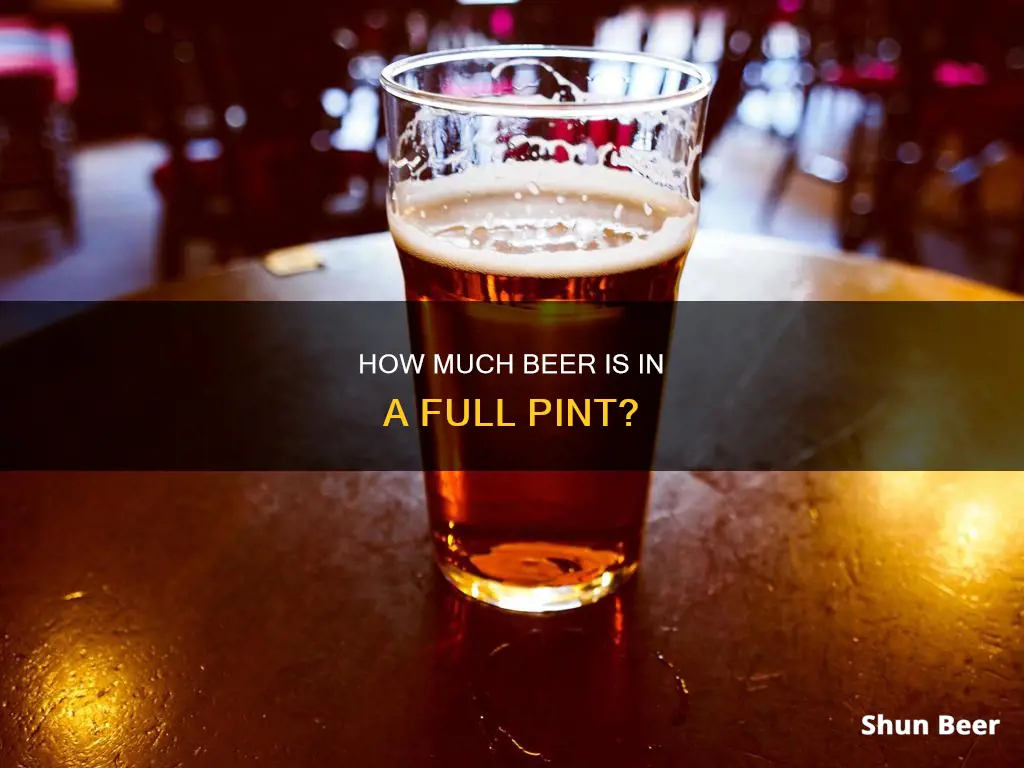
A pint is a standard unit of measurement for beer. The term pint refers to a unit of volume or capacity in both the imperial and United States customary measurement systems. Interestingly, the size of a pint varies depending on the region and country. In the United States, a pint of beer is equivalent to 16 US fluid ounces or approximately 473 milliliters. On the other hand, the British imperial pint, used in the United Kingdom and Ireland, is larger, containing 20 imperial fluid ounces or about 568 milliliters. Other countries, such as Australia and Canada, have their own definitions of a pint, which may differ from the US and imperial measurements. Understanding these variations in pint sizes is crucial for beer enthusiasts and travelers alike.
| Characteristics | Values |
|---|---|
| Unit of volume | Imperial and United States customary measurement systems |
| Volume | 1/8 gallon |
| Imperial pint | 568 ml |
| Country | United Kingdom, Ireland, Commonwealth nations |
| American pint | 473 ml |
| Country | United States |
What You'll Learn

The imperial pint: 568ml
The imperial pint, also known as the British imperial pint, is a unit of volume or capacity in the imperial and United States customary measurement systems. It is equal to one-eighth of an imperial gallon or 20 imperial fluid ounces. This amounts to approximately 568 millilitres or milliliters.
The imperial pint is used in the United Kingdom, Ireland, and to a limited extent in Commonwealth nations. In the United Kingdom, it is mandatory to sell draught beer in imperial measures, and English, Scottish, and Northern Irish law require certain steps to ensure that a pint of beer is indeed a pint. This can be achieved through "metered dispense" (calibrated pumps) or, more commonly, the use of certified one-pint glasses. These certified glasses are typically etched with the letters "CE" and the certifying agency's identification number.
The size of a pint varies depending on the country. For example, a pint in the United Kingdom, Ireland, and most European countries is 568 millilitres, while a pint in the United States is smaller, at 473 millilitres.
The history of the imperial pint dates back to the 17th century when King Charles II of England standardised the measurement to 568 millilitres, bringing consistency to tavern servings and preventing disputes.
IPA vs Doppelbock: A Beer Style Face-Off
You may want to see also

The US pint: 473ml
The US pint is smaller than the imperial pint, with a volume of 473ml. This is equivalent to 16 US fluid ounces. In the US, a liquid pint is legally defined as one-eighth of a liquid gallon of exactly 231 cubic inches.
The US pint is the standard unit of measurement for beer in the US. While the standard serving size of beer in the US is 12 fluid ounces, a pint is a popular option in many bars across the country. The typical conical "pint" glass in the US holds 16 fluid ounces when filled to the rim. However, due to the foamy "head", the actual liquid fill is often less than this.
The US pint is about 20% smaller than the British imperial pint, which is used in the United Kingdom and Ireland and to a limited extent in Commonwealth nations. The imperial pint holds 568ml, or 20 imperial fluid ounces.
The size of a pint varies depending on the country. While the US and the UK have standardised the pint as a unit of measurement, almost all other countries have standardised the metric system.
Beer Nuts: A Tasty Treat with a Unique Difference
You may want to see also

Pint glasses: different shapes and sizes
The pint is a unit of volume in both the imperial and United States customary measurement systems, where it is traditionally one-eighth of a gallon. The British imperial pint is about 20% larger than the American pint. The former is used in the United Kingdom and Ireland, and to a limited extent in Commonwealth nations, while the latter is used in the United States. The size of a pint varies depending on the country you are in.
American Pint Glass
The standard American pint glass is heavy-bottomed with straight, tapered sides. This type of glass is versatile and can be used to serve any style of beer. It is nicknamed the "shaker" as it is the perfect size and shape to pair with a cocktail shaker for mixing drinks. It is also easy to stack and store, and can be used for water or soda.
Imperial Pint Glass (Nonic Glass)
The imperial pint, also known as an English pub glass or nonic glass, is the standard pint glass used in the UK. Similar to the American pint glass, the nonic glass features a bulge near the lip of the glass, which adds to its structural durability and makes it less likely to be chipped. It also fits comfortably in the hand and stacks well. It is generally used as a multipurpose glass, but some say that the curvature of the glass is best suited to ales and stouts.
Other Types of Beer Glasses
There are many other types of beer glasses, including the pilsner glass, the weizen glass, the snifter glass, the tulip glass, the goblet, the IPA glass, the stout glass, the stange glass, the beer mug, and the beer boot. Each of these glasses has unique characteristics that enhance the drinking experience for different styles of beer. For example, the pilsner glass is tall and skinny, showing off the hue and effervescence of light, golden-colored beers, while the stout glass is designed to complement the dark, roasted flavor and creamy mouthfeel of stout beers.
Exploring the Canadian Pint and Its Beer Capacity
You may want to see also

Beer servings: 12-16oz cans/bottles
The standard serving size for beer cans or bottles is 12 ounces, while 16 ounces is also a common option. These sizes are typically sold in 4-, 6-, 12, 15, 18, 24, and 30-packs. The 12-ounce option is preferred by some consumers because it is easier to drink in one sitting, takes up less space in the refrigerator, and stays cold until finished. Additionally, the smaller serving size allows for greater variety when consuming multiple beers. On the other hand, the 16-ounce option is favoured by those who want a larger serving similar to a draft pint and prefer to buy less cans overall.
The preference for 12- or 16-ounce cans or bottles of beer is subjective and varies among consumers. Some individuals opt for 12-ounce servings because they find them easier to consume in a single sitting without the beer getting warm. The smaller size also allows for more variety when trying different beers, as one can indulge in multiple flavours without committing to a larger serving. Additionally, 12-ounce cans or bottles take up less space in the refrigerator, making it convenient to store more beer or other items.
However, others prefer the 16-ounce option as it provides a larger serving that matches the size of a draft pint. Consumers who opt for this size may be looking for a more substantial drinking experience and are willing to pay for the extra volume. From a business perspective, breweries can sell 16-ounce cans for a similar price as a draft pint, making it a profitable choice. Additionally, some individuals feel that drinking three 16-ounce servings results in consuming less beer overall compared to drinking four 12-ounce servings.
The choice between 12- and 16-ounce servings also depends on the context and drinking occasion. For instance, 12-ounce cans or bottles are preferred when one wants to savour the beer and enjoy its flavour, while 16-ounce servings are chosen when the intention is to get drunk. Furthermore, the 12-ounce option is more suitable for social gatherings or when packing beer into a cooler, as it allows for easier sharing and distribution.
Beer Consumption: Is Seven Pints Excessive?
You may want to see also

Global variations: different pints worldwide
The size of a pint varies depending on the region and country. The British Imperial pint, used in the United Kingdom and Ireland, is about 20% larger than the American pint, containing 568ml (or milliliters) compared to the US liquid pint's 473ml. This is because, while both are traditionally one-eighth of a gallon, the imperial gallon is larger than the US gallon.
In some countries, the term "pint" is used colloquially to refer to a different volume of beer. In South Australia, for example, a "pint of beer" will get you 425ml, whereas you need to specifically ask for an "imperial pint" to get 570ml. In Quebec, Canada, ordering "a pint of beer" in English will get you 568ml, but the same order in French ("une pinte de bière") is legally a larger imperial quart (1136ml). In Flanders, a "pintje" or "little pint" is just 250ml.
In some countries, the metric system has replaced the pint as the standard unit of measurement. In France, a standard 250ml measure of beer is known as "un demi" or "a half". In Germany, "ein Schoppen" is used for roughly half a litre.
Seltzer vs Beer: What Sets These Drinks Apart?
You may want to see also
Frequently asked questions
A pint is a standard unit of measurement for beer. The US pint contains 16 fluid ounces or 473 millilitres, while the British imperial pint contains 20 fluid ounces or 568 millilitres.
No, the size of a pint varies by country. For example, a pint in the UK, Ireland, and most European countries is 568 ml, while in the US, it is 473 ml.
In medieval England, there was no standard measure for a pint, and tavern keepers would use their own mugs and tankards, leading to disputes with customers. In the 17th century, King Charles II of England established the "imperial pint" as a standard measure, which is still used in the UK and Ireland today.
There are several common shapes of pint glasses, including conical or sleever glasses, nonic glasses, jug glasses or dimple mugs, tulip glasses, and can-shaped glasses. Each design has unique features for improved grip, stacking, and preventing breakage.
The type of beer you drink will impact the number of beers in a pint. Lighter ales and lagers have lower alcohol content, so it is suitable to drink multiple pints. In contrast, beers with higher alcohol content, like pale ales and pilsners, should be consumed more slowly.







